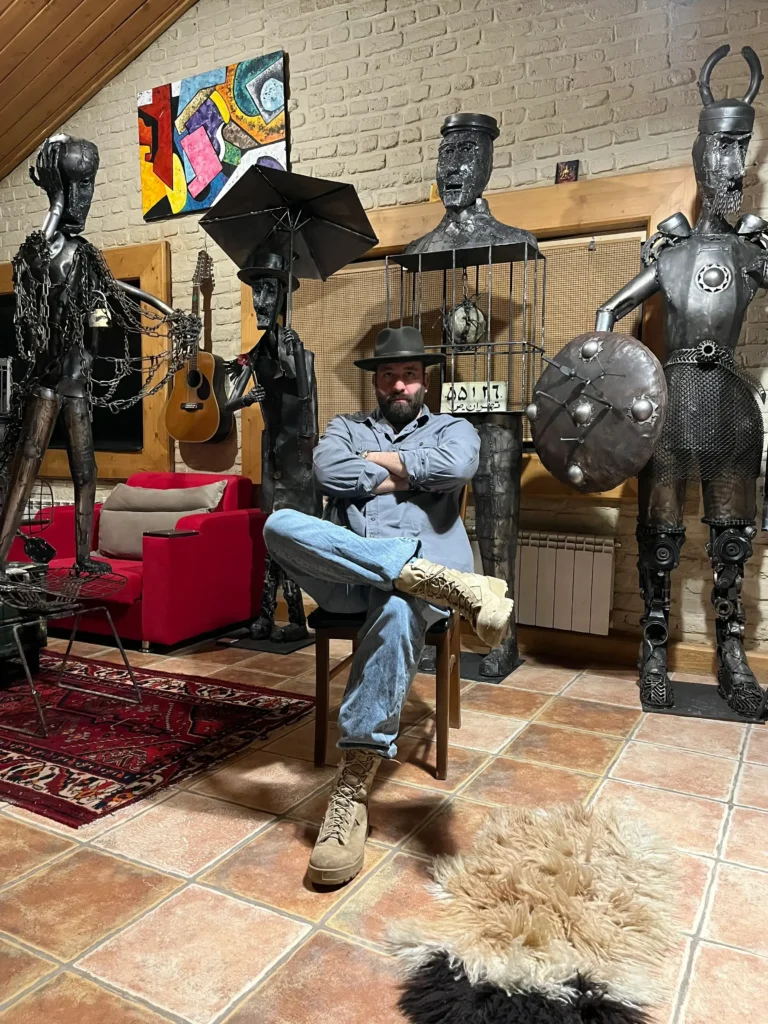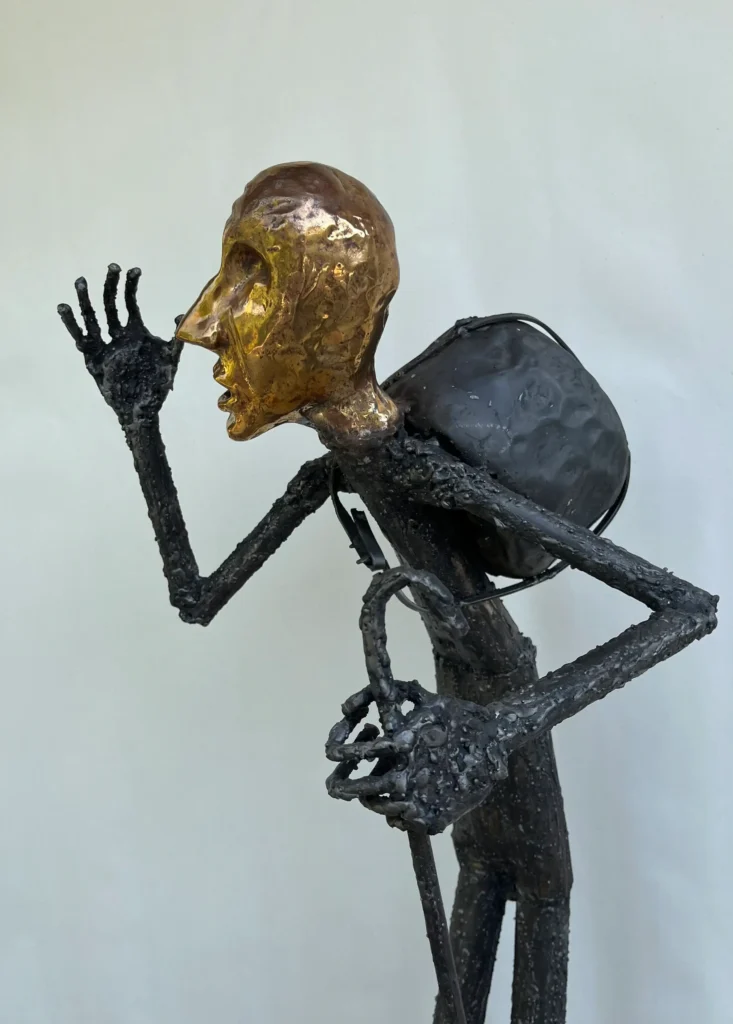-
Please introduce yourself (biography) and state the starting point and time you began your artistic activities.
I am Saman Shadanloo, known by the artistic name Ilkhan. I started sculpting at the age of 13 or 14. My father was a manufacturer of industrial parts, and I used to go to his factory and ask him to give me work, but he was against it. I started working in an unused warehouse, using factory waste to create handmade items learning through trial and error.
For many years, I created artwork for fun and for myself, not considering it a job to earn income. I thought that becoming an artist would be a bad thing. Many nights, I worked late in the workshop that I had access to, making sculptures and gaining experience. I studied two fields: architecture, which I abandoned, and genetics, but I have yet to work in my field. What I was interested in became my path, and I became an artist. I believe this is my mission in this world.
My story began with sorrow. My father was diagnosed with cancer, the worst kind, and I was going crazy; nothing could bring me peace. They told me that in two months, my father would no longer be in this world. I started creating my first figurine collection, depicting my kneeling sculptures and asking God to help heal my father. But my father passed away, and my work and mission began. I cried over the statue every night, creating sculptures. I would stay in a workshop I had rented around Tehran, working and building. My battle with this cruel world began. I say the world is cruel; I will be happy when everyone is free from need.
-
The golden point of artists’ idea creation is generally inspired by a subject, person, or event in their lives. Please tell us where the idea for your artwork began.
My ideas come from the events of my life, the things I see, and, of course, from listening to music. This means that the events that have happened, combined with music, create a work of art. I make from the pain and suffering of this world, the wounds I have received from people, and the unnecessarily inflicted blows upon each other.
-
Transforming recycled materials into a work of art is an interesting process. What is the name of the artistic style you create, and what trends or influences do you incorporate into your works? Please describe this journey in detail.
In fact, I do assemblage art with metal scraps, and sometimes, I create works with clay and sculpting paste, which I then transform into bronze to make it more durable.
-
Music, painting, sculpture, welding! Your artistic dimensions are multi-faceted. Please explain each branch and state which one you feel you belong to the most. (Also, provide explanations about your works in each of the branches.)
I am inclined towards sculpture, but an artist should not be one-dimensional and should also strive to explore other artistic fields. I am a self-taught sculptor, or perhaps it’s better to say I learned from God. Similarly, I learned to paint and sing in my dreams. This is the first time I am revealing this secret because you get mocked by people.
I have loved music since childhood and always wanted to sing. During the day, I made sculptures; at night, I painted and practiced singing. I invited good musicians to my workshop and sought their guidance, or I went to them to learn a bit from each person, absorbing a lot from their words. I recorded my first song when my father stopped coming to my dreams. I sang a song for him called “Silence of the Ilkhan,” which gained much attention after its release. Everyone was downloading it, and I went to several places where I heard my music playing in restaurants.
-
What message do you convey to your audience with your artistic creations? How do the audience’s reception and reactions to your work manifest?
Through my works, I am telling my audience to love each other, practice kindness, and not hurt each other so much. All my works are about lovers who are waiting for their lost love and hope to see their beloved again, but there is no other beloved. Without listening to anyone, my sculptures are waiting for the day when they may see love again.
-
Which artist’s work do you admire most in the art world, and what draws you to their art?
Da Vinci’s works. He was fascinating and creative, and of course, Van Gogh, who has also become my nickname in Iran, “Van Gogh of Iran.” Da Vinci, for his creativity in his works, and Van Gogh, for his love, allowed him to escape from this ruthless world through painting and find peace. While I am working, it feels like I am not in this world, and when suddenly someone calls me, I jump as if I have been startled.
-
Please tell us about your experience of being outside the borders of Iran. In which countries and galleries have you participated? From which countries has there been more reception? What is the global community’s response to your work? Are there similar examples in the world?
I exhibited my work in Dubai, Turkey, Italy, France, and Canada. The first time I visited an international exhibition, I had a strange fear. However, when I attended the exhibition with many artists worldwide, I saw that Iranians have something to say about art. My work won an award, and I noticed that they, or their new generation, cannot compete with Iranian artists. They know how to create, but they lack substance; it’s just a pretty piece they say is good and then move on. I believe an artistic work should impact the audience profoundly, reminding them of many things that have happened in their lives. All the works were by Iranian artists.
-
Engaging in avant-garde and less experienced arts is very risky. How have you navigated the journey’s difficulties, and could you share some of your challenges?
This is a good and challenging question. Since my work is modern, many people don’t understand it. I present my work with more popular music so that everyone can understand it, regardless of their cultural and social level. So far, many audiences have considered my work like their children’s and enjoyed it.
-
What impact do artificial intelligence and modern technologies have on the process of artistic works? Do you use these tools? Please express your overall opinion on this matter.
I am not good with technology. I have neither used artificial intelligence nor know how to work with it.
-
How do you envision the future path? Please explain your upcoming plans for your fans, both domestically and internationally.
A promising future is on the way, and I want to hold workshops in other countries.
-
What advice do you have for young and eager artists looking to create works of art?
My recommendation is that they do their own work, the work that comes from their heart, the work they love, and not listen to the opinions of others because some people want to divert them from their path. This exists in all professions. They should remain persistent in their work. Ultimately, art is humanity’s last place and safe haven. Without art, humans would first go mad and then die.








